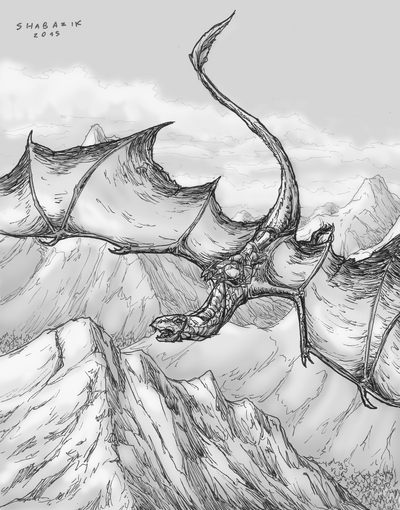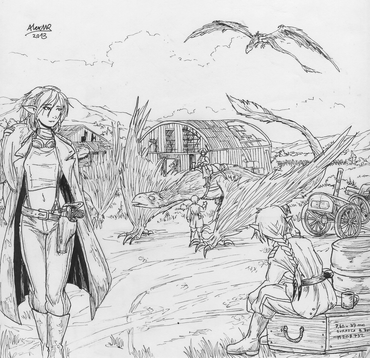
A wind rider and a fighter plane in the Modern Age
Wind Riders were soldiers or warriors who fought mounted on the back of flying creatures -as opposed to flying creatures or peoples of Aiers, or later modern flying machines. The role of the Wind Rider largely depended on the type of mount for them to be used, and their function; primarily for delivering messages, scouting, ground attack or aerial combat.
Overview[]
Early Purposes[]
Wind Riders were originally an answer since the earliest of times from elves to face their flying enemies, as they tried to domesticate flying creatures: since then, Wind Riders will provide an important advantage over enemies that didn't have them -however, mostly their use was as scouts, rather than in actual combat, unless fighting against flying creatures.-
Another element of Wind Riders warfare was the psychological impact a Wind Rider could inflict on an opponent, knowing itself watched and defenseless, and that the enemy could drop from the skies.
Evolving Roles and Symbolism[]
In the period of the Anglasecuarnian Wars, many wind rider units were converted to aircraft units, because of the losses sustained during the war and the difficulties training creatures and raiders. However, some Wind Riders units still served afterwards.
Most Wind Riders units that are flying creatures-mounted in modern armies serve in purely ceremonial roles, or as a stealthy, silent flying unit in certain areas of operations where it's difficult to operate. Modern usage of the term generally refers to specialists units of aerial combat aces.
History[]
Early[]
Due the presence of flying creatures -as Dragons, gryphs, great eagles, hipogryphs and other flying creatures- and flying peoples –as Car'Haad, Harpy(ies) and some kinds of demons, among others-, the importance of dominion over the skies was presented quite early in the history of Aiers.
Wars of the Power[]

An Ozcura Orc mounted on a wyvern Dragon in service to the Dark Legion
However, often humanity overlooked this aspect of warfare, and while during the First War of the Power, the previous demonic-car’haad war had depleted the flyers of the Dark Legion, and they didn’t play an important role. After the war, a handful of human knights learned to ride flying beasts as flying knights, or more likely, had elves in their employ who would ride them. The situation largely remained static, but flyers in human kingdoms were a valued (and expensive) auxiliary component to a kingdom's military. Much prestige was gained in having them, which was often a principal reason for their presence.
The Dark Legion capitalized on their superiority in the skies in the Second War of the Power, which made humans take a renewed notice of the importance of the flyers, especially after their allied High elves used air mounted cavalry to scout movements of the armies of the dark legion, to deploy their forces. Such flyers were invaluable to countering the Dark Legion and maneuvering human armies and linking them up in the Battle of the plains of Sargos.
Since then –and specially, after the Third War of the Power and The Cataclysm-, all the main human armies tried to keep at least a small force of flying creatures in their service, to fulfill roles as explorers and messengers.
The role of elves as riders[]
A problem for this was, however, was that humans couldn’t fly: either they get for these roles flying allies –as Car’Haad-, or flying beasts to be mounted:
Humans didn’t trust much the Car’Haad, lower demons and Harpies...
But humans proved to have poor –terrible- results domesticating flying creatures: because of this, they had to rely, even against their wishes, to non-humans: elven beast masters, who could domesticate, and actually ride, the flying beasts.
These elves under human service crossing the skies, will become the Wind Riders. Due the strategic and tactical advantages of sky observation, aside of better communications between distant armies, as said, all human armies tried to have flyers and Wind Raiders: However, not all of them could, as there were few flying creatures, and fewer riders of them, being the process of domestication and training, of flyers and riders, extremely slow and difficult. Because of this, the Wind Riders never became one of the divisions of the armed forces –navy and army-, and not even, a fraction of the armies –infantry, cavalry and artillery-.
Rivalry of Technology[]

Elven Wind Riders based at an 'aerodrome'
For centuries, only the wind riders, riding their flying beasts, would dominate the skies.
Balloons[]
At least, until some humans began to try to develop alternatives. The first attempts, of aerostatic balloons, were seen just as curious experiments: experiments that were, however, watched carefully by some nations who didn’t have access to their own Wind Riders.
Advent of Airplanes[]
Slowly, human flying devices would develop, but the superiority of the Wind Riders will be uncontested… at least, until the creation of the airplanes.
The first airplanes were slow and difficult to maneuver, and weren’t mechanically reliable: because of this, the wind riders laughed at the clumsy human attempts to reach the sky. As well, the traditionalist commanders of the armed forces of the first powers of Aiers, didn’t believe in these new experiments, useful only for a fair and an exposition of inventions, but not for war.
Economics[]
But then again, the nations who didn’t have flyers and wind riders, followed closely these developments. As well, while domesticating a flyer and training a wind rider could take decades, planes were easier and cheaper to build, and easier, to train the pilots.
Because of this economical and practical reason, even with the distrust of the high command, began to enter in service more and more airplanes. Clumsy and slow, they were no match for the majesty, speed and ability of the flyers and their Wind Riders.
Advance of Airplane Technology[]

Wind Riders still operated well into the industrial Modern Age
But with the Anglasecuarnian Wars, one more time humans will take a technological leap, because of the attempts to make it easier to make humans kill other humans.
At the beginning of the Anglasecuarnian Wars, the use of air planes and wind riders was still limited to exploration roles –being much of their communication roles relegated, due the advances in communications-.
While the soldiers of the sky weren’t expected to fight, often the wind riders and pilots carried pistols and rifles. It was then during the early stages of the war, when Wind Riders decided to try to use their flyers more aggressively, to attack and destroy the enemy observation planes and globes, using the same flying beasts natural weapons –such as claws and teeth-, or the weapons carried by the Wind Riders.
As a response to these attacks, observation airplanes began to carry machineguns. However, against the flyers, was still not enough. Because of this, were later developed the “hunters” airplanes, for aerial combat against Wind Riders, rather than to serve as observation airplanes.
While the Hunter planes were too slow, easy to break and clumsy for the Wind Riders, As the war progressed, each loss of the Wind Riders was irreparable, meanwhile was easier to build airplanes and train pilots.
Airplanes Replace Wind Riders[]
Slowly, one by one, the Wind Riders of both sides of the war began to fall in combat, and their numbers diminished: A clear sign of this, was the evolution of the hunter-planes, from a design to face Wind Riders, into fighter-planes, designed for aerial airplane-on-airplane combat.
It will still be needed years for the airplanes to be capable of even reaching the Wind Riders and their flyers maneuverability and speed… but what displaced them from the battlefield was in the end the costs.
Despite this, several nations will keep still for decades their Wind Riders, but mostly in colonial scenarios, where the lack of mechanical spare parts, airfields or fuel made the use of airplanes less effective. Other units were only kept for their ceremonial value.